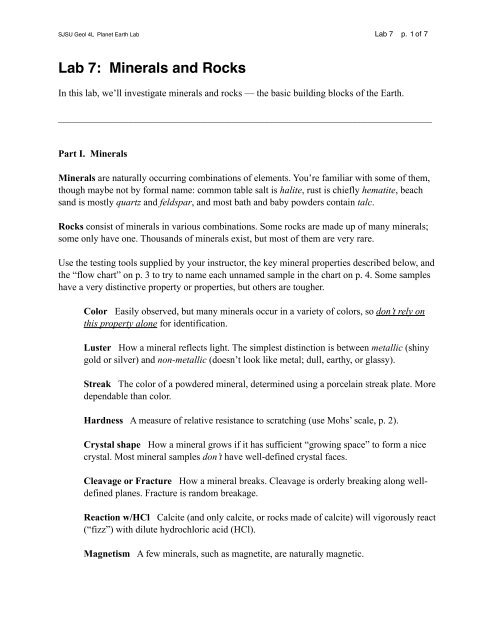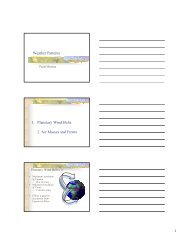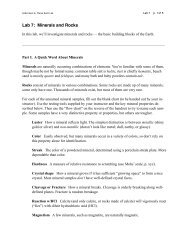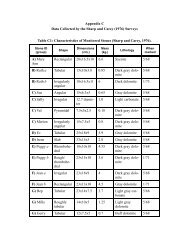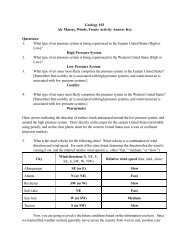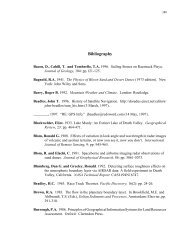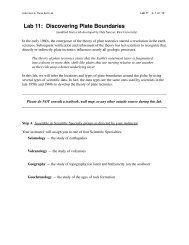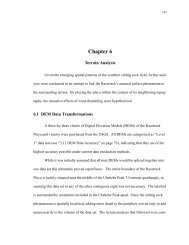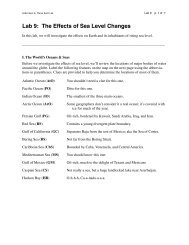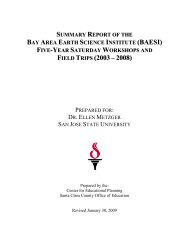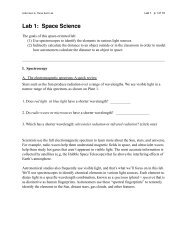Lab 7: Minerals and Rocks
Lab 7: Minerals and Rocks
Lab 7: Minerals and Rocks
Create successful ePaper yourself
Turn your PDF publications into a flip-book with our unique Google optimized e-Paper software.
SJSU Geol 4L Planet Earth <strong>Lab</strong> <strong>Lab</strong> 7 p. 1 of 7<br />
<strong>Lab</strong> 7: <strong>Minerals</strong> <strong>and</strong> <strong>Rocks</strong><br />
In this lab, we’ll investigate minerals <strong>and</strong> rocks — the basic building blocks of the Earth.<br />
_____________________________________________________________________________<br />
Part I. <strong>Minerals</strong><br />
<strong>Minerals</strong> are naturally occurring combinations of elements. You’re familiar with some of them,<br />
though maybe not by formal name: common table salt is halite, rust is chiefly hematite, beach<br />
s<strong>and</strong> is mostly quartz <strong>and</strong> feldspar, <strong>and</strong> most bath <strong>and</strong> baby powders contain talc.<br />
<strong>Rocks</strong> consist of minerals in various combinations. Some rocks are made up of many minerals;<br />
some only have one. Thous<strong>and</strong>s of minerals exist, but most of them are very rare.<br />
Use the testing tools supplied by your instructor, the key mineral properties described below, <strong>and</strong><br />
the “flow chart” on p. 3 to try to name each unnamed sample in the chart on p. 4. Some samples<br />
have a very distinctive property or properties, but others are tougher.<br />
Color Easily observed, but many minerals occur in a variety of colors, so don’t rely on<br />
this property alone for identification.<br />
Luster How a mineral reflects light. The simplest distinction is between metallic (shiny<br />
gold or silver) <strong>and</strong> non-metallic (doesn’t look like metal; dull, earthy, or glassy).<br />
Streak The color of a powdered mineral, determined using a porcelain streak plate. More<br />
dependable than color.<br />
Hardness A measure of relative resistance to scratching (use Mohs’ scale, p. 2).<br />
Crystal shape How a mineral grows if it has sufficient “growing space” to form a nice<br />
crystal. Most mineral samples don’t have well-defined crystal faces.<br />
Cleavage or Fracture How a mineral breaks. Cleavage is orderly breaking along welldefined<br />
planes. Fracture is r<strong>and</strong>om breakage.<br />
Reaction w/HCl Calcite (<strong>and</strong> only calcite, or rocks made of calcite) will vigorously react<br />
(“fizz”) with dilute hydrochloric acid (HCl).<br />
Magnetism A few minerals, such as magnetite, are naturally magnetic.
SJSU Geol 4L Planet Earth <strong>Lab</strong> <strong>Lab</strong> 7 p. 2 of 7<br />
Mohs’ Scale of Relative Hardness (“What scratches what?”)<br />
The hardness of a mineral can be tested by scratching. A mineral can only be scratched by a<br />
harder substance. A hard mineral can scratch a softer mineral, but a soft mineral can not scratch a<br />
harder mineral. Therefore, a relative scale can be established simply by seeing which mineral<br />
scratches another. The scale proposed by the French mineralogist Friedrich Mohs (in 1812) is<br />
still used throughout the world. The higher the number, the harder the mineral.<br />
The list also includes several common items that can be used to help determine the relative hardness<br />
of a mystery mineral.<br />
1 Talc<br />
2 Gypsum<br />
3 Calcite<br />
4 Fluorite<br />
5 Apatite<br />
~2.5: fingernail<br />
~3.5: copper penny<br />
~5.5: window glass or typical knife blade<br />
6 Orthoclase<br />
7 Quartz<br />
8 Topaz<br />
~6.5: streak plate or good steel file<br />
9 Corundum<br />
10 Diamond<br />
_____________________________________________________________________________<br />
FYI: The Mohs scale scale is relative, not absolute; fluorite (4) is not twice as hard as gypsum<br />
(2). Here’s the true relation among these ten minerals, setting talc as the baseline (= 1).<br />
1 Talc<br />
3 Gypsum<br />
9 Calcite<br />
21 Fluorite<br />
48 Apatite<br />
72 Orthoclase<br />
100 Quartz<br />
200 Topaz<br />
400 Corundum<br />
1600 Diamond
SJSU Geol 4L Planet Earth <strong>Lab</strong> <strong>Lab</strong> 7 p. 3 of 7
SJSU Geol 4L Planet Earth <strong>Lab</strong> <strong>Lab</strong> 7 p. 4 of 7
SJSU Geol 4L Planet Earth <strong>Lab</strong> <strong>Lab</strong> 7 p. 5 of 7<br />
Part II. <strong>Rocks</strong><br />
In this part of the lab, we’ll examine examples of the most common igneous, sedimentary, <strong>and</strong><br />
metamorphic rocks. Complete (in any order) each of the three stations located around the room.<br />
A. Igneous rocks<br />
Igneous rocks form when molten magma or lava cools (the ign- prefix means fire in Latin).<br />
When magma stays underground, it cools very slowly. The resulting rock consists of interlocking<br />
crystals visible to the naked eye. These are plutonic rocks (after Pluto, god of the underworld).<br />
plutonic: underground; big crystals<br />
When magma erupts on Earth’s surface, it cools quickly. The resulting rock consists mostly or<br />
completely of crystals that are too small to see. These are volcanic rocks (after volcanoes).<br />
volcanic: on Earth’s surface; few or no crystals<br />
The composition of igneous rocks also is important to geologists, but we’ll just use the following<br />
informal rule of thumb: Lighter-colored rocks have more silica (SiO2); darker-colored rocks have<br />
relatively less.<br />
lighter: more SiO2 darker: less SiO2<br />
Look carefully at your samples of granite <strong>and</strong> rhyolite.<br />
1. Which is relatively coarser-grained? ____________________<br />
2a. Which cooled more quickly? ___________________ 2b. Why do you think so?<br />
Now look at the samples of gabbro, diorite, <strong>and</strong>esite, <strong>and</strong> basalt.<br />
3a. Which are plutonic? ________________________________ 3b. Why do you think so?<br />
4a. Which probably have the least SiO2? _______________________ 4b. Why do you think so?<br />
Some volcanic eruptions produce lava that cools so quickly that no crystals grow at all. Two examples<br />
of these glassy-looking rocks are obsidian (be careful of its sharp edges) <strong>and</strong> pumice.<br />
5. Why do you think pumice has such a low density?
SJSU Geol 4L Planet Earth <strong>Lab</strong> <strong>Lab</strong> 7 p. 6 of 7<br />
B. Sedimentary rocks<br />
History of a typical sedimentary rock: (1) <strong>Rocks</strong> (of any type) are exposed at Earth’s surface <strong>and</strong><br />
erode (broken down) into bits of s<strong>and</strong>, gravel, <strong>and</strong> mud—collectively known as sediment.<br />
(2) Sediment is transported downhill, usually by running water, <strong>and</strong> deposited in low-lying areas<br />
like valleys, lakes, <strong>and</strong> oceans. Sediment is deposited in layers that geologists call beds.<br />
(3) Accumulated sediment turns into sedimentary rock when it compressed (by the overlying<br />
sediments) <strong>and</strong> cemented together (by chemical precipitates from ocean water or groundwater).<br />
Examine the bowls of loose sediment, <strong>and</strong> the samples of s<strong>and</strong>stone <strong>and</strong> conglomerate.<br />
1. S<strong>and</strong> is to s<strong>and</strong>stone as ____________ is to conglomerate.<br />
2. How would you describe the difference(s) between the s<strong>and</strong>stone <strong>and</strong> conglomerate?<br />
3. In what way(s) are the s<strong>and</strong>stone <strong>and</strong> conglomerate similar (i.e., more similar to each other<br />
than to an igneous rock)?<br />
4. Some sedimentary rocks, such as limestone, contain fossils—the remains of ancient plants <strong>and</strong><br />
critters. Find the samples with fossils. What types of fossils are present? (just use general, everyday<br />
terms).<br />
5. Find sample C6R-84-VIII. Estimate how much of this rock is composed of fossils: _______ %<br />
6. Sedimentary rocks also tell us about the environment in which the sediments accumulated.<br />
Find the sample labeled ripples. Based on what you know about where modern ripples can be<br />
found, where do you think the sediment in this rock may have been deposited?
SJSU Geol 4L Planet Earth <strong>Lab</strong> <strong>Lab</strong> 7 p. 7 of 7<br />
C. Metamorphic rocks<br />
Metamorphic rocks form when pressure, temperature, or corrosive fluids change the texture or<br />
mineral composition of any pre-existing rock (which could have been an igneous, a sedimentary,<br />
or even a different metamorphic rock). We will divide metamorphic rocks into two types:<br />
Foliated metamorphic rocks look streaked, sheeted, or b<strong>and</strong>ed. In a foliated rock, flat<br />
minerals are roughly parallel to one another due to tectonic squeezing of the rock.<br />
Unfoliated metamorphic rocks either weren’t squeezed very hard, or don’t have<br />
enough flat minerals to show a foliation.<br />
Compare the samples of shale <strong>and</strong> slate. Shale, a sedimentary rock made of compacted mud, is<br />
dull, earthy, <strong>and</strong> comparatively lightweight. Slate, a metamorphic rock, is somewhat shiny, foliated,<br />
<strong>and</strong> denser. Don’t continue until you’re sure you can see these differences.<br />
1. Which of your metamorphic rock samples is foliated?<br />
a. slate? yes b. schist (“shist”)? ______ c. gneiss (“nice”)? ______<br />
d. marble? ______ e. quartzite? ______ f. serpentinite? ______<br />
When metamorphism happens at high temperature<br />
<strong>and</strong> pressure, rocks may deform like soft plastic.<br />
Find the folded rock sample.<br />
2. Draw a picture in the space at the right showing<br />
the direction of compressional force necessary to<br />
produce the folding you see in this rock (experiment<br />
with a sheet of paper).<br />
Find the serpentinite, which is California’s state rock. Serpentinite forms when corrosive fluids<br />
metamorphose the rocks of Earth’s mantle. Serpentinite is pretty rare, <strong>and</strong> most of it is found on<br />
the ocean floor. Serpentinite followed a long, arduous trek to get from the ocean floor to the California<br />
hills where we found it, so please be nice to it.<br />
3. Why do you think serpentinite has that name? Before you answer this question, look at as<br />
many serpentinite samples as possible.


